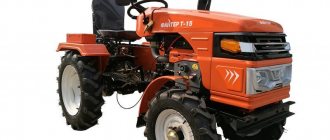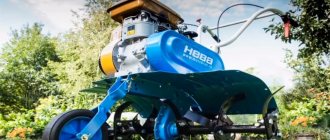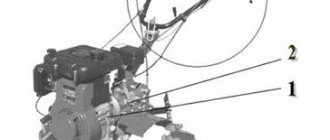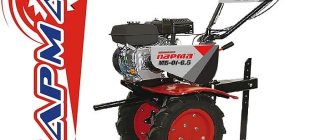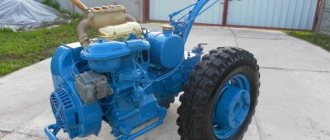Updated: 02/19/2021 18:37:10
Expert: Andrey Nikolaevich Kuznetsov
*Review of the best according to the editors of expertology.ru. About the selection criteria. This material is subjective in nature, does not constitute advertising and does not serve as a purchase guide. Before purchasing, consultation with a specialist is required.
If you have a spacious summer cottage or your own land in the field, then you have probably thought about purchasing a walk-behind tractor. With such a device, you can cultivate the soil at a speed identical to a tractor, but it takes up much less space and costs less. You can save even more if you buy a Chinese walk-behind tractor. Among them there are worthy options that our experts selected based on product characteristics and customer reviews. The review was compiled based on an analysis of the technical characteristics of walk-behind tractors on the website https://rankquality.com/tillers-cultivators/.
Rating of the best Chinese walk-behind tractors
| Nomination | place | Name of product | price |
| The best Chinese light-duty walk-behind tractors | 1 | Huter MK-7000 7 hp | 21 450 ₽ |
| 2 | PATRIOT Pobeda (440 10 7212) 7 HP | 33 290 ₽ | |
| The best Chinese mid-class walk-behind tractors | 1 | Huter MK-11000(M) 11 hp | 49 090 ₽ |
| 2 | PATRIOT Nevada 9 9 HP | 54 490 ₽ | |
| 3 | LIFAN 1WG900 7 HP | 29 249 ₽ | |
| 4 | Carver MT-701 7 HP | 27 017 ₽ | |
| 5 | PATRIOT Vegas 7 HP | 27 197 ₽ | |
| The best Chinese heavy-duty walk-behind tractors | 1 | Huter MK-9500 9.5 hp | 46 690 ₽ |
| 2 | PATRIOT Boston 9DE 9 HP | 72 990 ₽ |
Which walk-behind tractor should I choose? Gasoline or diesel?
The disadvantages and advantages of a diesel walk-behind tractor over a gasoline one come from the difference between a diesel and gasoline engine. The diesel engine has a low speed, is more economical and can withstand the loads of hilling, plowing and cultivation very well. However, during maintenance they require more attention than gasoline ones.
When started manually, gasoline engines performed better. That is why experts recommend purchasing diesel walk-behind tractors with an electric starter, which significantly increases its cost.
It is the low cost of the gasoline engine that is its main advantage. Servicing a gasoline walk-behind tractor is also much easier.
All gasoline engines have forced air cooling, while diesel versions have both air and water cooling. Typically, such engines are installed on heavy walk-behind tractors.
So it’s up to you to decide which walk-behind tractor you choose (gasoline or diesel), based on your financial capabilities and your needs when cultivating the land.
Owner reviews
Kirill Vavilov, 39 years old, Astrakhan: “I purchased a Zarya walk-behind tractor. Good buy. It's a pleasure to work with a 10 liter machine. With."
Savchenko Oleg, 50 years old, Vologda: “I’ve been looking for a diesel walk-behind tractor for a long time. I bought a device Zubr with a capacity of 10 hp. With. and remade it. I took out the frame for the front wheels and installed the seat. The machine works well with the cutter and plow.”
Vladimir, 32 years old, Izhevsk: “I paid for the walk-behind tractor in October 2017, received it in December. I didn’t start the engine because it happened in cold winter. Started it up in the spring without any problems. Idled for a few hours, then hit the road. I didn’t have time to plow the garden: the clutch fell apart. I'm looking for a spare disk."
Sergey Mitroshin, 67 years old, Ildibaevo: “I bought a Scout 15 DE walk-behind tractor. I dug potatoes with a vibrating potato digger. Works good. I plowed the garden. The car is powerful, but too heavy.”
Features of the device of Bright-135 walk-behind tractors
Bright-135 differs from its “younger brothers” in the company in that it is heavier; equipped with powerful engines with a capacity of 9 horsepower, as well as a fuel tank with increased capacity (in some modifications – up to 6.5 liters).
The Brait-135 walk-behind tractor is equipped with a gearbox and a disc-type clutch. It has a significant working and tillage width (from 0.8 m to 1.20 m) and is equipped with hardened milling knives. It can be used not only on light soils, but also on any type of soil, including heavy and virgin soils. The processing depth when using a cutter ranges from 150 mm to 350 mm.
The wheels are installed with a large diameter, with a powerful tread of 5x12 tires. When used with a cart, the Bright-135 walk-behind tractor can transport loads weighing up to six hundred kilograms. The power take-off shaft allows you to use the walk-behind tractor engine as a drive for a great variety of types of attachments. Hexagon - S31.
The Brait-135 walk-behind tractor is equipped with a universal hitch and is easily compatible with all types of attachments, including other brands of walk-behind tractors (in particular Cascade, Neva, etc.) With its increased capabilities, Brait-135, at the same time, remains very compact and maneuverable model. The steering rod has additional rubberized pads that improve control of the device.
The traction characteristics of a walk-behind tractor increase significantly with the use of special lugs. Overall dimensions of the Bright-135 walk-behind tractor: 1010×570×775 mm.
How to choose a walk-behind tractor
Before purchasing, you should once again analyze for what purpose the equipment is being purchased. For example, to process plots of up to 8 acres, it is worth looking at budget models, including Centaur walk-behind tractors. They are distinguished by the strength of the metal from which they are made and good engine performance. The equipment easily bears the load throughout the day. The recommended model is Centaur 3060B.
For a plot area of up to 20 acres, it is recommended to take a closer look at semi-professional walk-behind tractors. There is also a Centaur 2060B walk-behind tractor here. He is accompanied by Sadko M 900 and Aurora 105.
When the plot area is several hectares, then professional walk-behind tractors come to help farmers. Among them there are also “Centaurs”: 1081D and 1013D.
The Aurora MT-101DE and Aurora MT 125 D equipment have also proven themselves well over large areas.
The engines of diesel walk-behind tractors are one of the main ones in the overall design. In other words, this is the heart of the unit. Changing it is not difficult, especially since components for Chinese walk-behind tractors are always available. But in order for the equipment to work properly right away, it is best to run it in before using the walk-behind tractor. “Weaknesses” in the general condition will immediately be identified, which can be repaired in a matter of time. If the carburetor is acting up, then it is enough to adjust the valve.
DIY repair
Repairing a diesel engine yourself is not easy. The motor has a complex design. Malfunctions and methods for eliminating them are described in the instructions for the motor cultivator. Let's look at the most common breakdowns:
- Nozzle clogged. In this situation, you need to remove the part, clean and rinse it, and put it in its place.
- Easily cranks the engine with the starter. This is evidence of insufficient compression. The cylinder head gasket needs to be replaced and the nuts tightened. If necessary, replace the piston rings.
- The starter mounting screws are loose. For this reason, the starter cord does not return to its place. The screws need to be adjusted.
- The starter is malfunctioning. This may be due to a spring that has received a lot of wear. The repair consists of replacing the starter spring.
In winter, diesel engines often start poorly and smoke. Storing it in a damp room causes:
- oxidation of contacts;
- destruction of wire insulation;
- appearance of water in oil.
Before starting the engine, you need to check these weak points and eliminate the causes of the malfunctions. After this, the engine can be started. To start you need:
- prepare good fuel;
- pour a little of it into the cylinder;
- set fire to;
- release gases from the cylinder.
Malfunctions also occur during operation. In this case, you need to stop the engine and cool it. After this, check the condition of the rods and the oil level in the crankcase. In case of complex breakdowns, it is better to seek help from specialists. It may be necessary to adjust the valves or replace rings, pistons, or connecting rods. Timely repairs are the key to high-quality and long service life of the walk-behind tractor.
The principle of operation of a diesel walk-behind tractor
The diesel engine in a walk-behind tractor looks like a gasoline engine. Inside it are the same cylinders, connecting rods with pistons. Differences can be found in the ignition of the fuel. In a gasoline engine, the fuel mixture is ignited by a spark; in a diesel engine, by the temperature in the cylinder. Air first enters the cylinder and is compressed by the piston. Due to compression, the temperature rises to +700...+900˚С. As the piston approaches TDC (top dead center), diesel fuel is injected into the chamber under pressure, which is ignited by the heated air.
This internal structure of the cylinders and ignition system makes it possible to use cheap fuel in the form of diesel fuel.
Fuel consumption is minimal with maximum efficiency. Disadvantages include increased noise and vibration levels, difficulties in starting the engine at low temperatures. But these shortcomings are gradually being eradicated and do not cause big problems.
Engine and transmission
“Brait-135” walk-behind tractors are equipped with the already mentioned four-stroke air-cooled engines, which were made by Chinese developers in the image and likeness of the popular Japanese small-sized single-cylinder engine Honda GX 390. The working volume ranges from 0.212 to 0.42 liters, power – from 7 to 15- ty horsepower.
At a more affordable price, the Chinese engine is endowed with a number of advantages of the original Japanese engine. It is economical, has high torque and good elasticity in operation. The engine has liner cylinders, a significantly increased service life, improved heat dissipation, and decent power and performance capabilities. The fuel consumption of the Brait-135 engine is 1-2 liters of gasoline per hour, depending on the workload.
Two modifications are equipped with single-cylinder diesel engines of a simple and reliable design, also copied from the Japanese.
The clutch mechanism is gear type. The gearbox is gear-type, designed for significant loads. Number of gears – 2 forward and 1 reverse. Supported engine oil type: 5W-30, 10W-30, SAE-30.
Advantages and disadvantages
The diesel engine installed on motor cultivators gives them some advantages:
- there is no problem of harmful emissions;
- low fuel consumption;
- the heavy weight of the unit makes it stable;
- the diesel engine has a long service life;
- high efficiency;
- ease of use;
- compactness;
- speed of work;
- high reliability.
The disadvantages include the following:
- limited maneuverability;
- high price;
- a lot of noise when working;
- problems when starting in the cold season;
- large overall dimensions.
When purchasing equipment, you need to pay attention to the capacity of the cultivator’s fuel tank. With a small capacity, you will have to fill it with fuel more often.
Modifications in the Brait-135 line
The catalog of the official website of the Bright company currently offers 11 modifications of Bright-135 walk-behind tractors, two of them are diesel . Let's talk about them first.
- Brait-135DEA (diesel) – this option is equipped with a 4-stroke, single-cylinder diesel engine BR-178FE, vertical air-cooled, with direct injection, with electric start (battery included). The power of this engine is 7 horsepower, its working volume is 296 cm3. Cylinder diameter x stroke – 78 x 62. Output shaft: 25 (for splines). Milling cutter shaft: hexagon D=32. Engine oil capacity – 1.1 liters. Gearbox oil volume: 2.3 l. Fuel tank capacity – 3.5 liters. Walk-behind tractor weight: 138 kilograms.
- Brait-135DEB (diesel) – equipped with a 4-stroke, single-cylinder BR-186FAE diesel engine, vertical air-cooled, with direct injection, with electric start (battery included). The power of this engine is 10 horsepower, its working volume is 418 cm3. Cylinder diameter x stroke – 86 x 72. Output shaft: 25 (for splines). Milling cutter shaft: hexagon D=32. Fuel tank capacity – 5.5 liters. Engine oil volume – 1.65 l. Gearbox oil volume: 2 l. Walk-behind tractor weight: 148 kilograms.
Gasoline:
- Brait-135GA – with a 4-stroke, single-cylinder BR-170F engine. The working volume of this engine is 212 cm3, its power is 7 horsepower. The starter is manual. Output shaft: 20 (keyed). Milling cutter shaft: hexagon S32. Oil capacity 1.1 l. Gearbox oil volume – 2.0 l. The volume of the fuel tank is 3.6 liters. Walk-behind tractor weight: 136 kilograms.
“Behind the wheel” of a light petrol walk-behind tractor Brait-135GA.
- Brait-135GB – equipped with a 4-stroke, single-cylinder BR-177F engine with a working volume of 270 cm3, 9 horsepower, with a manual starter. The weight of the walk-behind tractor in this modification is 143 kilograms. The volume of the fuel tank is 6 liters. Oil capacity: 1.1 l. Gearbox oil volume – 2.3 l. The cutter shaft is a hexagon D=32.
- Brait-135GBD is a walk-behind tractor with technical characteristics similar to the Brait-135GB model, but also equipped with a differential. The weight of this walk-behind tractor is 150 kilograms.
- Brait-135GBE – equipped with a 4-stroke, single-cylinder BR-177FD engine. Its working volume is 270 cm3, power – 9 horsepower. Starter with electric start (battery included). Output shaft: 25 (keyed). Milling cutter shaft: hexagon S32. The volume of the fuel tank is 6 liters. Engine oil volume: 1.1 l. Gearbox oil volume: 2 liters exactly. The weight of such a walk-behind tractor is 156 kg.
- Brait-135GC - with a 4-stroke, single-cylinder engine with a power of 13 horsepower and a displacement of 389 cm3. The starter in this modification is manual. The volume of the fuel tank is 6.5 liters. The weight of the walk-behind tractor is 150 kilograms. Milling cutter shaft: hexagon S32.
- Brait-135GCE - also with a 4-stroke, single-cylinder engine with a power of 13 horsepower and a displacement of 389 cm3. But with electric start (battery included). The volume of the fuel tank is 6.5 liters. The weight of the equipment in this modification is 163 kilograms.
- Brait-135GD - equipped with a 15-horsepower 4-stroke, single-cylinder engine with a working volume of 420 cm3. The starter is manual. The volume of the fuel tank is 6.5 liters. The weight of the walk-behind tractor is 148 kilograms.
- Brait-135GDE – also with a 4-stroke, single-cylinder gasoline engine with a displacement of 420 cm3 and a power of 15 horsepower. But equipped with electric start (battery included). The weight of the walk-behind tractor in this modification is 163 kilograms.
- Brait-135GDD is a walk-behind tractor, similar in its technical characteristics to the Brait-135GD modification, but equipped with a differential. The weight of the walk-behind tractor in this version is 153 kilograms.

